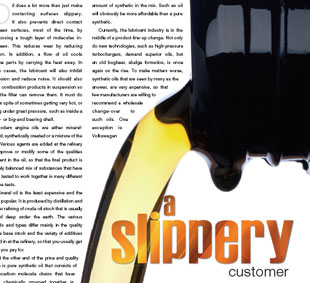Slippery customer

Oil may just be oil to most, but there’s a lot more to it than that, writes JAKE VENTER
Oil does a lot more than just make contacting surfaces slippery. It also prevents direct contact between surfaces, most of the time, by interposing a tough layer of molecules in-between. This reduces wear by reducing friction. In addition, a flow of oil cools engine parts by carrying the heat away. In many cases, the lubricant will also inhibit corrosion and reduce noise.
It should also keep combustion products in suspension so that the filter can remove them. It must do this in spite of sometimes getting very hot, or being under great pressure, such as inside a main- or big-end bearing shell.
Modern engine oils are either mineral-based, synthetically created or a mixture of the two. Various agents are added at the refinery to improve or modify some of the qualities inherent in the oil, so that the final product is a finely balanced mix of substances that have been tested to work together in many different engine tests.
Mineral oil is the least expensive and the most popular. It is produced by distillation and further refining of crude oil stock that is usually buried deep under the earth. The various brands and types differ mainly in the quality of the base stock and the variety of additives mixed in at the refinery, so that you usually get what you pay for.
At the other end of the price and quality scale is pure synthetic oil that consists of hydrocarbon molecule chains that have been chemically grouped together in combinations that do not exist in nature, to form a superior lubricant. These molecules are more consistent in size and shape, so that they are better able to withstand extreme hot and cold temperatures. They also offer more protection at high bearing pressures than a mineral oil could. The major downside is the price of over R80 per litre in South Africa.
Semi-synthetic oil, blended from a mixture of the two, is often a good compromise, but the quality will depend on the amount of synthetic in the mix. Such an oil will obviously be more affordable than a pure synthetic.
Currently, the lubricant industry is in the middle of a product line-up change. Not only do new technologies, such as high-pressure turbochargers, demand superior oils, but an old bugbear, sludge formation, is once again on the rise. To make matters worse, synthetic oils that are seen by many as the answer, are very expensive, so that few manufacturers are willing to recommend a wholesale change-over to such oils. One exception is Volkswagen South Africa. They have recently demanded that all their engines must be filled with synthetic oil, or else customers lose warranty protection.
Oils are graded according to a performance specification as well as a viscosity rating. Most oil cans list performance ratings from the ACEA (Association des Constructeurs Europeans de l’Automobile) as well as from the API (American Petroleum Institute). Sometimes an American MIL (military) or specific engine manufacturer rating is also included. These performance grades are updated whenever a particular problem occurs with a particular engine design, resulting in a new and usually improved performance standard. The list of grades and their meaning is long, but all one really needs to know about these grades is that they exist, normally appear on the oil container and should agree with the oil specified in the owner’s handbook supplied with the vehicle. The container will also state whether it is a mineral, semi-synthetic or synthetic oil.
The Society of Automotive Engineers (SAE) viscosity ratings are also important, because they specify how easily an oil flows. Single-grade oils are denoted by the numbers SAE 0 to SAE 60, with lower numbers indicating an oil that is more free-flowing.
Multi-grade oils meet the low temperature viscosity levels of one SAE number at some temperature below 0oC, as well as a different SAE viscosity number at 100oC. The different viscosities are denoted by two numbers separated by the letter W. For example, 20W40 would be therefore behave like an SAE 20 oil (relatively free-flowing) at below-zero temperatures, and like an SAE 40 oil (relatively non-free-flowing) at 100oC.
There is a continuous debate in the oil industry, the transport industry and even among private motorists about oil change intervals. Technically, the shortest intervals are the best for the engine, but it’s often uneconomical to stray too far away from a manufacturer’s recommendation. Diesel engine change intervals should also be closer together because of the unwanted sulphur in the fuel that causes acid formation. These acids end up in the oil, and for this reason, diesel engine oil contains more antacid.
Finally, a word of caution against adding any aftermarket substance to the oil: Any good oil is a mix of substances that have been checked by means of endurance runs on the road and on engine dynamometers to ensure that they are compatible and perform as claimed. This means that any aftermarket substance, even if apparently beneficial, could upset the balance and harm the engine.
Published by
Focus on Transport
focusmagsa




